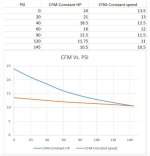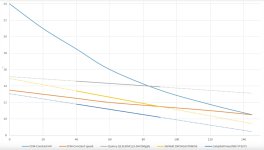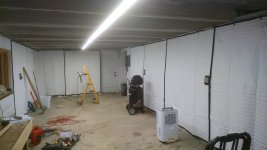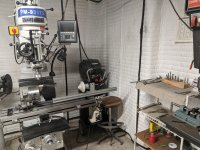I started reading this thread, got to page 8 and saw I have 10 more to go. I'm on a lunch break and don't have time to get caught up, but I thought I would share my work. I'm in the middle of building a custom compressor because I couldn't find anything on the market that met my wants. I want: very quiet, very fast charge-up, clean & dry air, and good efficiency.
This isn't within the scope of quieting the compressor but it's my main feature and worth talking about. My compressor (at startup) runs in constant horsepower mode, rather than constant speed mode. A typical compressor runs at a fixed speed, and as horsepower is a function of speed (RPM/CFM) and torque (FT*LBS/PSI) doesn't reach its nameplate horsepower spec until right before it shuts off from the pressure switch. Mine when you switch it on goes to double speed and stays there until pressure climbs enough that it reaches the 3HP mark. Then it gradually slows as pressure builds, and right before the pressure switch trips is when the RPMs finally come down to normal 3HP motor speeds. So in the 0-40psi range my 3HP compressor is moving more air than a typical 7.5HP compressor. This allows me to charge my tank much faster than I should be able to. Here's the graph of my compressor in constant HP mode vs constant speed mode (like a typical compressor).

And here's a graph of it against a handful of comparable 3HP and 5HP compressors.

I achieve this using a 5HP harbor freight compressor head, a 3HP 3-phase motor, and a VFD.
The VFD is the key, not only to a faster charging compressor, but also to
noise reduction. Someone in the first 8 pages said that speed reduction is a huge improvement and that's absolutely true. With the normal fixed speed compressor that we're all used to, a slow leak or small tool usage leads to a startling instantaneous transition from quiet to a deafening roar; from 0 to max speed in an instant, to get back to max pressure and then shut off as fast.
It doesn't need to be this way. With a VFD we can program a gentle ramp up to speed so nobody sharts or spills coffee when it's time to go. And we can even program a feedback loop with a pressure
sensor instead of a pressure
switch, so that if your system pressure is 145PSI it doesn't wait until pressure drops to 100PSI and then haul buns to get back to 145. As soon as pressure drops below 140 we can creep into action very slowly, very quietly, just a few RPM*, to get back to 145. And if it sees pressure continue to drop even as it is charging slowly (someone is using an air tool), it charges faster. And faster. And faster, until it starts to see pressure climb again (we are charging faster than draining) and stay at that speed until charged again. This what I call "pressure keeping" mode, and the compressor enters this mode as soon as initial charge-up is complete.
The result is a system that recognizes and responds to need, proportionally. It only gets excited when you need it to. Then it makes some noise. But if you're using that much air, you're already making noise. No more silence punctuated with apocalypse.
And when it does make noise, I'm accounting for that too. I've made up a silencer from a bucket and it's very effective. At max speed It's a far cry from silent, but it is definitely still more quiet than any consumer grade piston compressor that I know of, apart from some of the California Air Tools products and most screw/scroll compressor (even quieter than some of those). I plan to quiet it even more with a foam-lined metal enclosure
Here is a video demonstration of my compressor running with the muffler unattached, and then attached.
And here is a video demonstration of the constant horsepower mode: (link, because apparently I'm only allowed to embed one video)
Finally up on VFD power - YouTube
More details here:
What limits the speed of an air compressor? | Page 3 | The Hobby-Machinist
*note: most piston compressors are splash lubricated and require a minimum RPM to maintain lubrication. In order to run "just a few RPM" an oil pump is needed, and planned in my build. I cannot currently run "just a few RPM."



